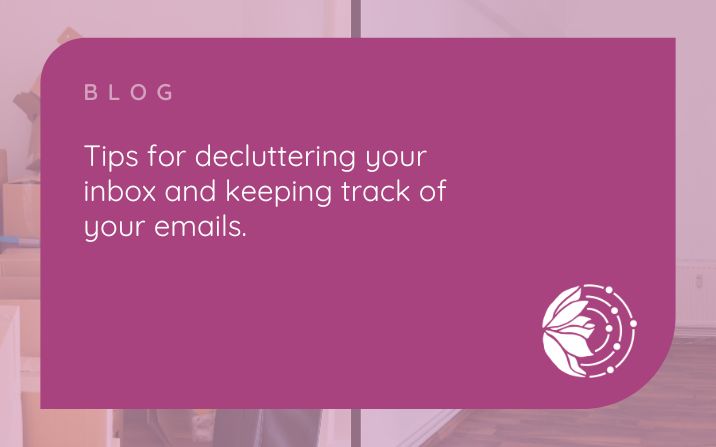From Chaos to Calm: Your Roadmap to a Managed Inbox
The way we communicate in our freelance gigs has taken a big turn over the last couple of decades. Gone are the days of jotting down notes on paper or having actual face-to-face meetings with clients. Now, it’s all about email and let’s be real, those inboxes can become a jungle if we’re not careful.
In this blog, I’m going to be sharing some of my top tips for making your email inbox more manageable and less overwhelming!
1 – The Two-Minute Rule for Quick Decisions
The ‘Two-Minute Rule’ originates from David Allen’s time management method, “Getting Things Done.” The premise is simple: if a task can be completed in two minutes or less, do it immediately.
Apply this rule while sifting through your inbox. If an email requires a response or action that will take less than two minutes, deal with it straight away. Forward it, respond to it, or file it. This tactic significantly reduces the clutter in your inbox and saves you time in the long run.
For emails that need more than two minutes, don’t let them languish and become a source of stress. Instead, add them to your task manager or ‘to-do’ list, ensuring that they get the attention they deserve at an appropriate time.
2 – Make Use of Your Email Client’s Tools
Email clients offer a range of features designed to make inbox management easier. Flags and reminders can be used to keep track of important emails that need attention but are not immediately urgent, for example. If you can always add a reminder date – or add it to your task manager so you don’t miss them.
Categories or tags can be powerful tools to sort emails based on client, project, or urgency. I use these to identify which clients my emails are from, or what type of action they require – be creative and use the categories that are most meaningful for you.
Automating the sorting process through smart folders and filters can dramatically cut down the time you spend organising your inbox. Filters can automatically send emails to designated folders based on set criteria such as sender, subject line, or containing specific keywords. As a small business owner, filtering to folders such as ‘invoices’, ‘client correspondence’ and ‘prospects’ can help you locate and track important emails at a glance.
3 – Use Email Templates for Quick Responses and Customer Service
If you often find yourself sending similar replies to different clients or stakeholders, most email platforms offer some form of templated responses or shortcuts. Customise these to fit typical scenarios you encounter in your freelance work. This feature enables you to send polished, professional responses with minimal effort, freeing up your time for other pressing tasks.
You can read more about using email templates in my blog – The Easy Way to Create Customer Service Email Templates.
4 – Make Filing Emails a Habit
A cluttered inbox is not just an eyesore; it’s also a productivity killer. Emails that have been read and require no further action should not continue to occupy valuable space in your inbox. Develop the habit of moving these emails to designated folders.
I always move every email I’ve read out of my inbox into the appropriate folder for it as follows:
Action – you to take steps, whether it’s a reply, a call, or some research. These are also added to my to-do list.
For information – a folder for emails I need to read but haven’t had a chance to yet – again these are added to my to-do list.
Follow up – emails I’ve dealt with that I need to review at a later date – again also added to my to-do list.
All other emails that I’ve read, actioned or are effectively ‘closed’ are filed in my email filing system so that I have them on record if I need them in the future.
5 – Have Designated Email Checking Times
How many of you keep your email open all the time and open new emails the minute they pop up on your screen? I too am guilty of this at times. Keeping your email client open all day can be a significant distraction. Each new email notification tempts you away from your current task, scattering your focus.
Implementing designated email-checking times can counter this issue effectively. Consider dedicating specific blocks of time to manage your inbox and sticking to that schedule as rigorously as possible. ‘I couldn’t possibly do that‘ I hear you say – but why not? Do you regularly get emails that are so urgent they need responding to immediately?
An ‘Out-of-Office’ automated response can be a helpful tool here. Contrary to popular belief, these are not just for when you are on holiday. A carefully crafted message can let senders know your email-checking schedule, adding a personal touch and setting their expectations accordingly. This way, you can handle urgent matters via phone calls, while everything else waits for its designated time, thus enhancing your productivity.
Now go ahead and set yourself set times of the day to check your emails – I find half an hour first thing, half an hour at lunch and half an hour at the end of the day are great times for this.
6 – Unsubscribe ruthlessly
Let’s be honest: your inbox is likely home to newsletters, subscriptions and promotional emails that you never read. These messages are the secret culprits behind a cluttered inbox that seems to require endless scrolling. Not only do they drown out critical client communications and project updates but they also chip away at your focus and productivity, forcing you to sift through irrelevant information.
Your email should be a tool that aids your freelance work, not a constant distraction. Therefore, it’s time to go on an ‘unsubscribe spree.’ Schedule a recurring appointment in your calendar, say once a month, to actively comb through your inbox for subscriptions you don’t need. When you find them, don’t hesitate—hit that unsubscribe button.
The trick is to be discerning. Ask yourself, “Does this subscription add value to my work or life?” If the answer is ‘yes,’ by all means, keep it. But be prepared to re-evaluate this regularly. Your interests, industry focus and even client base may change and your subscriptions should evolve accordingly.
Mastering your email inbox is more than just a chore; it’s an essential skill for the modern professional. The strategies outlined here are tried-and-tested methods for reclaiming not just your inbox but also your time and focus. Implement them in your daily routine and you’ll experience a marked improvement in your productivity and peace of mind.

